
THE ROLE OF THE STRATUM CORNEUM
When performed correctly, exfoliation sheds old layers of skin and encourages a new, fresher layer, helping the complexion look flawless. The skin is comprised of multiple layers: the hypodermis, the deepest layer; the dermis, where collagen and elastin are produced; and the epidermis, the final layer of the skin.
 The stratum corneum, which sits atop the epidermis, is composed of several very-thin layers of dead skin cells that are mixed with layers of cholesterol, ceramides, and fatty acids. The stratum corneum is often referred to as the skin barrier. Many believe that the stratum corneum is useless because it is composed of dead skin, however, the function of these final layers is vital because they protect the underlying tissue from bacteria, microbes, toxins, and potential skin infections. The stratum corneum is also crucial in preventing moisture from the deeper layers of the skin from evaporating; this moisture is essential in helping the skin look younger and plumper. The stratum corneum can be thought of as the ultimate defense for the skin.
The stratum corneum, which sits atop the epidermis, is composed of several very-thin layers of dead skin cells that are mixed with layers of cholesterol, ceramides, and fatty acids. The stratum corneum is often referred to as the skin barrier. Many believe that the stratum corneum is useless because it is composed of dead skin, however, the function of these final layers is vital because they protect the underlying tissue from bacteria, microbes, toxins, and potential skin infections. The stratum corneum is also crucial in preventing moisture from the deeper layers of the skin from evaporating; this moisture is essential in helping the skin look younger and plumper. The stratum corneum can be thought of as the ultimate defense for the skin.
Although it is composed of dead skin cells, the stratum corneum is very active, with new dead skin cells reaching the surface on a regular basis to replace the old layer. The top three to four layers of the stratum corneum are known as the stratum disjunctum. These layers are the ones that are regularly replaced in a complex process of renewal known as desquamation.
Science has yet to understand the exact mechanism that makes the skin renew itself, but it is known that skin cells have an internal clock that tells them when it is time to shed, a process that occurs about 28 days or so, depending on the individual. As men and women age, the mechanism of shedding old skin becomes compromised and, as a result, shedding significantly slows down. This delay results in a dead skin cell buildup that makes the complexion look dull and the skin look thicker and less toned. This appearance is often exacerbated by other aging signs, such as brown spots, fine lines, wrinkles, and loss of collagen and elastin in the dermal layer.
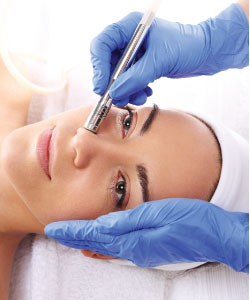
Exfoliation at any age is important, but it is critical for mature clients over the age of 40 because it is the only way to stimulate the regeneration of new cells and improve the skin clarity, tonicity, and overall appearance.
DRY SKIN AND TIGHT SCHEDULES
Very few people realize that with age, their skin tends to become dry; they do not recognize the importance of exfoliating on a regular basis to improve skin clarity and tonicity. Skin care professionals are often faced with the self-diagnoses of clients that are occurring more frequently. It is, therefore, important to help clients identify their skin type and understand what it means to exfoliate.
It is also crucial to explain to clients why they should make time for skin care. Everyone is busy and when clients are asked to add one more thing to their already-complicated life, it makes it difficult for them to hear the professional and follow their advice. Instead of telling them that they need to exfoliate, try to help them improve an aspect of their appearance with which they are concerned. When clients are approached with the following statement – "If you do (this), it will help you with (this concern)." – they are usually more willing to listen. It is also helpful to point out that exfoliation provides better skin care product penetration because clean pores absorb more products and that it creates a flawless base for makeup application. Makeup will go on more smoothly and less will be needed to cover imperfections.
METHODS OF EXFOLIATION
Microdermabrasion
As a very precise, machine-driven exfoliation method, microdermabrasion is still very popular and helps to polish the skin and improve skin tone. On its own, however, microdermabrasion may seem like too little to most clients. Therefore, adding a mud mask or a light peel after the treatment, as well as a facial massage, is recommended. These additions will give the client a more complete session and help them feel as if they are getting their money's worth.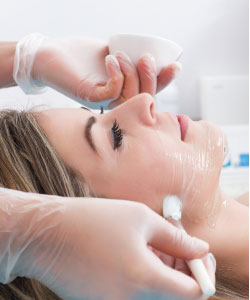
Crystal microdermabrasion, although it is not as common as diamond-tip microdermabrasion, uses aluminum oxide crystals, which pass through a vacuum tube, to exfoliate the surface of the skin. When using this device, professionals should take caution with clients that have underlying skin conditions such as rosacea, broken capillaries, or extreme skin sensitivity. In these situations, any harsh form of exfoliation should be minimized or avoided all together and replaced with a milder method.
Microdermabrasion not only helps to smooth the skin, but also to control oil production; eliminate dull skin; improve the appearance of enlarged pores, fine lines, and skin texture; reduce clogged pores and blotchiness; and enhance the effectiveness of chemical or light peels to reduce brown spots and hyperpigmentation.
Dermaplaning
This technique became popular a few years back and involves the use of an extremely sharp surgical blade to gently scrape away dead surface skin and soft facial hair. This technique helps to remove skin and should be followed with a light peel to help brighten any dark spots. Dermaplaning may produce less redness, so it can be easier on sensitive skin.
Because the use of sharp blades carry risks, it is extremely important for skin care professionals to have the proper training and properly assess the client's skin type and skin conditions before performing this treatment.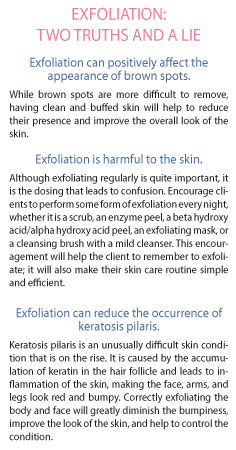
Some of the benefits of dermaplaning include enhancing the effectiveness of additional treatments, such as chemical peels; helping in the reduction of recent acne scars; and potentially providing an alternative for sensitized skin.
Manual Exfoliants
Skin care professionals have many options for manual exfoliation. Because scrubbing agents like nut powders get a bad rap, many new exfoliants contain small, spherical, all natural beads – like jojoba – that are extremely safe for any skin type. However, any scrub that is used properly is safe for the skin.
There are also enzyme-based scrubs, as well as some of the light acid scrubs that contain glycolic, salicylic, or lactic acids, that digest dead skin without the need to mechanically exfoliate. These ingredients act like chemical, rather than mechanical, exfoliants at a pH above 3. Professionals should first use a mild scrub, followed by a light peel. This combination enhances the effect and allows for better results of smoothness and clarity. For body treatments, the use of exfoliating gloves is recommended.
Cleansing Brushes
Although rotating and sonic brushes are mainly used as a cleansing device, they also have the ability to provide a decent exfoliation effect. When combined with the right cleanser, these devices have the ability to loosen dirt, especially around the nose area; this action unclogs pores and helps provide a deeper cleaning and an easier treatment for the skin care professional.
 Some clients may have concerns about the potential negative effects of cleansing brushes, wondering if these devices can lead to broken capillaries. Broken capillaries are caused by the sun and hereditary conditions. It is true that they can be exacerbated by overtreatment, but, in this case, exfoliation dosing is critical. That said, professionals should take care when using cleansing brushes on clients with sensitive skin or broken capillaries as some settings may exacerbate the client's condition.
Some clients may have concerns about the potential negative effects of cleansing brushes, wondering if these devices can lead to broken capillaries. Broken capillaries are caused by the sun and hereditary conditions. It is true that they can be exacerbated by overtreatment, but, in this case, exfoliation dosing is critical. That said, professionals should take care when using cleansing brushes on clients with sensitive skin or broken capillaries as some settings may exacerbate the client's condition.
The benefits of using a mechanical cleansing brush during a treatment include quicker cleaning, the loosening of clogged pores, superior oil removal, and a deeper cleansing in order to reduce the cost of further steps.
SENSITIVE AND SEVERLY ACNEIC CLIENTS
These two skin conditions are often complex for skin care professionals. It may be counterintuitive, but acneic skin should be treated the same way as sensitive skin. Manual scrubbing is still a very good way of gently sloughing off dead skin without harshness. Professionals can mix a scrub with a creamy cleanser to make it milder, being sure to carefully watch the client's skin to ensure no adverse effects take place during treatment. Light chemical or enzyme peels may be best for an acne-prone client. For sensitive skin, a patch test prior to any treatment is always recommended to avoid any unnecessary consequences.
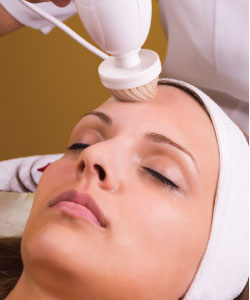 HOMECARE TREATMENTS
HOMECARE TREATMENTS
Skin care professionals should be heavily involved in the homecare options that their clients choose. Exfoliation should be done on a regular basis and professionals should carry retail options that will not only enhance their business, but also provide a reason for clients to return to the spa.
When it comes to homecare, many clients get busy and start scaling back on their regimen until they look at an old picture and realize that they may have been wrong. Slowing the aging process is hard work and takes consistency. Skin care professionals need to educate their clients on the value of staying consistent with treatments to avoid expensive procedures later on in life.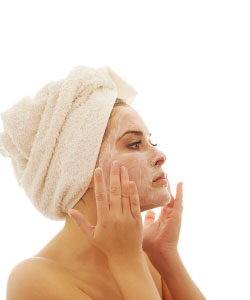
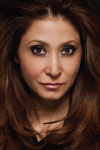 Christiane Waldron is the founder and CEO of Jenetiqa, a professional, luxury skin care company focused on providing highly bio-available skin care products that combine scientifically-proven antioxidants with natural botanicals and skin vitamins. Waldron is a chemical engineer by profession and is the chief scientist for Jenetiqa. She personally hand picks each ingredient in the formulas. Waldron's philosophy is to design and formulate multi-tasking products that help address all signs of aging.
Christiane Waldron is the founder and CEO of Jenetiqa, a professional, luxury skin care company focused on providing highly bio-available skin care products that combine scientifically-proven antioxidants with natural botanicals and skin vitamins. Waldron is a chemical engineer by profession and is the chief scientist for Jenetiqa. She personally hand picks each ingredient in the formulas. Waldron's philosophy is to design and formulate multi-tasking products that help address all signs of aging.

Want to read more?
Subscribe to one of our monthly plans to continue reading this article.